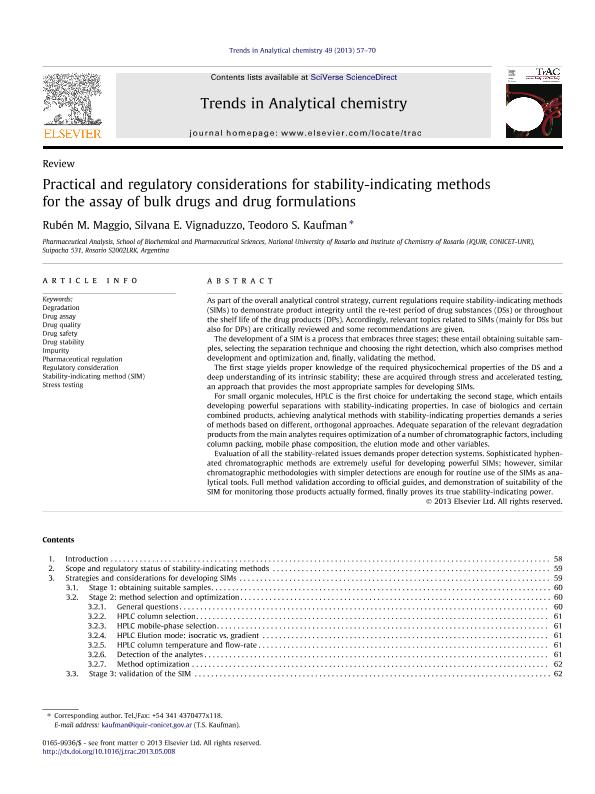Mostrar el registro sencillo del ítem
dc.contributor.author
Kaufman, Teodoro Saul

dc.contributor.author
Maggio, Ruben Mariano

dc.contributor.author
Vignaduzzo, Silvana Edit
dc.date.available
2016-06-02T18:27:02Z
dc.date.issued
2013-09
dc.identifier.citation
Kaufman, Teodoro Saul; Maggio, Ruben Mariano; Vignaduzzo, Silvana Edit; Practical and regulatory considerations for stability-indicating methods for the assay of bulk drugs and drug formulations; Elsevier; Trends In Analytical Chemistry; 49; 9-2013; 57-70
dc.identifier.issn
0165-9936
dc.identifier.uri
http://hdl.handle.net/11336/6003
dc.description.abstract
As part of the overall analytical control strategy, current regulations require stability-indicating methods (SIMs) to demonstrate product integrity until the re-test period of drug substances (DSs) or throughout the shelf life of the drug products (DPs). Accordingly, relevant topics related to SIMs (mainly for DSs but also for DPs) are critically reviewed and some recommendations are given. The development of a SIM is a process that embraces three stages; these entail obtaining suitable samples, selecting the separation technique and choosing the right detection, which also comprises method development and optimization and, finally, validating the method. The first stage yields proper knowledge of the required physicochemical properties of the DS and a deep understanding of its intrinsic stability; these are acquired through stress and accelerated testing,an approach that provides the most appropriate samples for developing SIMs. For small organic molecules, HPLC is the first choice for undertaking the second stage, which entails developing powerful separations with stability-indicating properties. In case of biologics and certain combined products, achieving analytical methods with stability-indicating properties demands a series of methods based on different, orthogonal approaches. Adequate separation of the relevant degradation products from the main analytes requires optimization of a number of chromatographic factors, including column packing, mobile phase composition, the elution mode and other variables. Evaluation of all the stability-related issues demands proper detection systems. Sophisticated hyphenated chromatographic methods are extremely useful for developing powerful SIMs; however, similar chromatographic methodologies with simpler detections are enough for routine use of the SIMs as analytical tools. Full method validation according to official guides, and demonstration of suitability of the SIM for monitoring those products actually formed, finally proves its true stability-indicating power.
dc.format
application/pdf
dc.language.iso
eng
dc.publisher
Elsevier

dc.rights
info:eu-repo/semantics/openAccess
dc.rights.uri
https://creativecommons.org/licenses/by-nc-nd/2.5/ar/
dc.subject
Degradation
dc.subject
Drug Assay
dc.subject
Drug Quality
dc.subject
Drug Safety
dc.subject.classification
Química Analítica

dc.subject.classification
Ciencias Químicas

dc.subject.classification
CIENCIAS NATURALES Y EXACTAS

dc.title
Practical and regulatory considerations for stability-indicating methods for the assay of bulk drugs and drug formulations
dc.type
info:eu-repo/semantics/article
dc.type
info:ar-repo/semantics/artículo
dc.type
info:eu-repo/semantics/publishedVersion
dc.date.updated
2016-06-01T13:33:39Z
dc.journal.volume
49
dc.journal.pagination
57-70
dc.journal.pais
Países Bajos

dc.journal.ciudad
Amsterdam
dc.description.fil
Fil: Kaufman, Teodoro Saul. Consejo Nacional de Investigaciones Científicas y Técnicas. Centro Científico Tecnológico Rosario. Instituto de Química Rosario; Argentina
dc.description.fil
Fil: Maggio, Ruben Mariano. Consejo Nacional de Investigaciones Científicas y Técnicas. Centro Científico Tecnológico Rosario. Instituto de Química Rosario; Argentina
dc.description.fil
Fil: Vignaduzzo, Silvana Edit. Consejo Nacional de Investigaciones Científicas y Técnicas. Centro Científico Tecnológico Rosario. Instituto de Química Rosario; Argentina
dc.journal.title
Trends In Analytical Chemistry

dc.relation.alternativeid
info:eu-repo/semantics/altIdentifier/doi/http://dx.doi.org/10.1016/j.trac.2013.05.008
dc.relation.alternativeid
info:eu-repo/semantics/altIdentifier/doi/10.1016/j.trac.2013.05.008
dc.relation.alternativeid
info:eu-repo/semantics/altIdentifier/url/http://www.sciencedirect.com/science/article/pii/S0165993613001428
Archivos asociados
